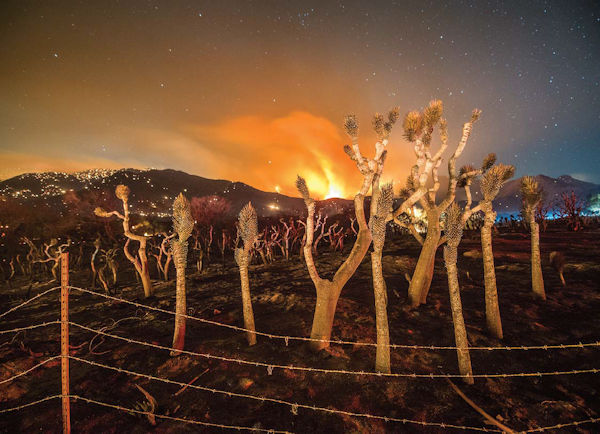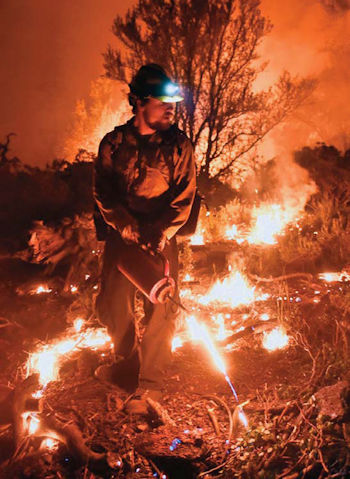SEJournal Online is the digital news magazine of the Society of Environmental Journalists. Learn more about SEJournal Online, including submission, subscription and advertising information.
Inside Story
Stuart Palley’s environmental photojournalism career follows a very natural cycle — it heats up (a lot) during the fire season.
Many photographers chase wildfires across the West every summer, especially as they become a bigger and more destructive player in global climate change. But in the last three years, Palley has set himself apart by developing a unique style that might best be described as nocturnal fire landscape photography.
Rather than pursue his subject close to the flames on the fireline, he will take in the entire fire scene from afar, sometimes miles away, to include the context of the fire as well as the fire. On clear nights, his pictures can include the Milky Way.
The resulting images have drawn enormous attention to Palley’s work, from the Pictures of the Year International competition last year, where he was a finalist for the Environmental Vision Award, to most recently a July double-page spread in Wired.
SEJournal photo editor Roger Archibald was able to catch up with the 27-year-old southern California native in late July as he was — what else? — headed off to another fire, the Sand Fire in Southern California. For many more photos by Palley, download the Fall 2016 SEJournal (see page 10).
 |
| Remnants of the Erskine Fire near Kernville, Calif., last June where the 19,000-acre blaze destroyed an estimated 100 homes, and caused two fatalities. Photo: © Stuart Palley |
SEJournal: What do you know so far about the fire?
Stuart Palley: Today is day four of the fire. It’s ten percent contained, and that hasn’t changed since the first day. It’s currently at 35,000 acres, burning through heavily drought-impacted chaparral, pine and desert scrub on the Angeles National Forest (about 35 miles northwest of downtown Los Angeles). It’s mostly burning on Forest Service land, but it’s been getting down in the flats and hitting structures in L.A. County.
This fire’s been doing what it wants. The crews have been doing a great job of dealing with some really strange fire behavior, but at the end of the day, the fire’s been kicking everyone’s ass. It’s probably a fatality fire at this point, unfortunately, and we’ve actually had two or three fatality fires thus far this season in California, a testament to how aggressive and extreme the fire behavior is this year.
SEJournal: How’d you get started in photography?
Palley: I started taking pictures in high school for the yearbook. And then when I was sixteen I went to Thailand where my uncle lived, and we ended up touring some of the areas that the 2004 tsunami had hit six months earlier. I was kind of taken in by this feeling of natural disaster. I responded by taking pictures and really connected to the situation by photographing it.
SEJournal: When did you get into journalism?
Palley: When I was in college, I worked with the newspaper, and got close to journalism that way, and decided that I wanted to try to be a photographer. So I went to grad school for photojournalism (at the University of Missouri).
SEJournal: What motivated you to make such a strong commitment to covering the fire story?
Palley: The summer before I returned to California, 2013, I interned at a paper that assigned me to cover a brush fire. There was this million-dollar home that was burning down, and the firefighters were trying to save things out of the garage. And I was very caught off guard by the whole scene, this interaction between nature and man, this natural force, our suburban sprawl in the wild and urban interface. I was really interested in documenting something that was going on in (the) backyard of where I grew up in Newport Beach, about an hour south of L.A.
I grew into it and started photographing at night. I started getting an interesting response, so I decided to keep rolling with it. It’s been nice that it’s been published in places that have helped to fund the project. But if it hadn’t been published, I’d still be doing the same thing, because it’s something that I personally enjoy. A lot of it’s hard work, (and) being out there away from civilization for days sometimes gets a little old, but it’s all worth it.
SEJournal: Do the firefighters you encounter also take pictures of the fires you cover?
Palley: In both the Forest Service and Cal Fire, you can’t take pictures on the job, because they’re paying you. And if you do, they own them. Sometimes they’ll take them on a quote/unquote ‘lunch break’ or something, but they’re really not allowed to otherwise.
SEJournal: How have you gotten around the administrative restrictions encountered by many journalists when they cover fires, and gain the access that you’ve achieved?
Palley: There’s really no set way to go about it. In California, we have the Media Access Law, which allows credentialed media to cover fires, earthquakes, floods and other disasters, but they’re on their own. It’s actually becoming a real problem. You have a lot of people who really aren’t journalists going to fires now, causing traffic jams. So I decided two seasons ago, that if I was going to do this, I wanted to do it the right way. I wanted to have the same training that a basic firefighter has, the same safety gear that I own, that I use, that I take care of, that I know is safe, that I know works. Good boots that don’t give you blisters, and a fire shelter — I keep one in my car and one in my pack, in case something happens.
SEJournal: When you get to an incident, can you just head out on your own, or do you work with public information officers?
Palley: Sometimes it’s just a matter of going up, showing your credentials, letting them know what’s going on, and going into the fire. Sometimes if I have time, I’ll check in with the command post in the morning, and the PIO shop, and they’re usually pretty cool with it. I have what’s called an “arduous duty” red card issued by the Forest Service, and that gets me a lot more access. I’m also technically on a Type II initial attack hand crew on the Cleveland National Forest. They brought me on to give me some idea of what it’s like to be a wildland firefighter, and also to document the crew, and help them with their recruiting. So having those credentials has been incredibly helpful.
SEJournal: Has being part of an actual fire crew influenced the approach you take to your own fire photography?
 |
| Fighting fire with fire, a member of the Big Bear Hotshots utilizes a drip torch to ignite unburned fuel during a firing operation at the 2015 Lake Fire on the San Bernardino National Forest. Photo: © Stuart Palley |
Palley: Most firefighters know that journalists really aren’t prepared, don’t have the right gear and don’t know anything about fire behavior. So when they know I’ve taken the basic training and have some experience under my belt, they feel much more comfortable around me, and know I’m not going to be a liability for them. And it really helps for access (to individual firefighters). It’s been a really cool lifestyle to learn about. And that really helps when writing a caption to try to tell a better story.
Some of these relationships have taken years to cultivate. Some of these people I consider my friends that I’d like to have a beer with. A lot of people on the crew are my age, really good, hardworking people that care about making a difference. And it’s just awesome to share time with them. They don’t get the same recognition that the municipal firefighters do, especially the Forest Service and BLM guys. So, I also try to shoot what they do. Sometimes I’ll just take their picture working and send it to them. And they’ll share it with their families, who’ll say, ‘I finally get to see what you do!’ For me, that really makes the project to hear that.
SEJournal: Does the work that you do during the fire season essentially pay for itself, or is that something that you support by your other off-season work?
Palley: It’s pretty close. I have to sacrifice some income to photograph the fires. It depends on how much camera gear I end up breaking during the year. But I’ll shoot for newspapers or string for wire services, and sell photos here and there. It certainly helps pay for the gas, the food and the car maintenance. I’ve tried to trade (photos) with companies for Nomex (fire resistant clothing) and things like that, which keeps the costs down. Overall it’s pretty close to breaking even. But regardless, there’s a huge value at being able to work on a project and being able to produce something creatively that you can’t put a price on.
SEJournal: How do you handle your photography business when you’re out on a fire? Is there somebody back at your office, or do you do it all yourself?
Palley: I’m doing it all myself, and sometimes I’d love to have somebody help me, because I’m getting all these requests when I’m on the road. I don’t really want to be in the middle of a fire negotiating with people about publishing rights. But it’s not a big enough part of my business right now.
SEJournal: When the fire season comes to an end, what sort of work do you do in the off-season?
Palley: A lot of the stuff I do isn’t pure journalism. I do commercial and advertising work to pay the bills. Especially in a place like Los Angeles, you can’t make a living as a freelance photographer doing only journalism. From a business standpoint, it’s not possible. Unless you’re living out of your truck, it doesn’t work. So in the off-season, I do corporate PR for the energy industry, fossil fuels, oil, natural gas pipelines, trying to make things that you wouldn’t necessarily think are interesting appear more visual. It’s all location work outdoors.
To be totally honest, a lot of times I enjoy that work more. There’s less drama, it’s better pay. And I realize I’m not going to be doing fire projects forever, because eventually I’ll probably have a family and a house and kids to send to college, so I want to be financially responsible in the long term. But I also don’t want to stop doing something that is very important to me personally and which people perhaps enjoy seeing. But it’s not going to last forever.
SEJournal: When you stop doing this sort of fire coverage, do you have any other environmental interests that you might devote your cameras to in the same way?
Palley: I’m very interested also in water issues. My masters’ project in grad school was on the Salton Sea, in southern California. It’s turning into a very slow unwinding ecological disaster. I’ll probably return and work on it a little more. As I have with fire, I want to try to do it in a different way. I’m also very interested in light pollution. Doing these fires in remote places has shown me how much the urban interface sometimes interferes with our night skies, so I’m exploring that too.
* From the Fall 2016 SEJournal.













 Advertisement
Advertisement 



